Welcome! This site is devoted to Priesmeyers everywhere and to their rich family history. If you are a member of the clan, you can learn about your ancestry, reaching back to the 16th century, and discover how you are related to your many Priesmeyer cousins around the world. And you can read stories and see photos of your branch of the family, adding your own if you like.
- Nearly all Priesmeyers today, whether in America or in Europe, are direct descendants of one household in northern Germany: farm number 3 in the village of Oppenwehe. The documented ancestry of the lineage and its many branches extends from this origin in an unbroken line from the late 1500s to the present.
- Nearly all Priesmeyers today, therefore, are provably related to each other, although often quite distantly.
- During the great wave of German immigration in the nineteenth century, 46 adult Priesmeyers
-
- 36 men and 10 women - - came to America, most of them between 1848 and 1882. Eighty percent settled in the Midwest, mainly in St. Louis, while the rest chose rural east Texas.
- Despite the predominance of immigrants to the Midwest, their descendants today comprise fewer than half of the Priesmeyers in America. The Texas branches were far more prolific, having chosen the farming life, with its large families, in contrast to their urbanized cousins in St. Louis, Chicago, Cleveland, and Cincinnati.
- The banner at the top of this page pictures notable Priesmeyers against a backdrop
of Mount Stemwede, near Oppenwehe. The stylized writing in the center is the family
name -
- spelled “Prissmeier” - - as written by the pastor in recording the 1665 marriage of Heinrich Priesmeyer and Anne Alheit Hilmer, direct ancestors of most Priesmeyers in America today.
If you’d like to know more, read on . . .
OPPENWEHE: THE PRIESMEYER HOME TOWN
Oppenwehe is a small farming village in northwestern Germany not far from the city
of Osnabrück. It sits on the sandy soil of the great Saxon plain and has a current
population of just over two thousand. As agricultural land it has always been marginal,
best suited to grazing animals and growing flax. Historians and archeologists agree
that it was first settled by Saxons, though sparsely, during the period from 500
to 800 AD. Following Charlemagne’s conquest and conversion of the Saxon tribes in
the late 8th century, the existing settlements were awarded to his secular and religious
retainers as feudal estates.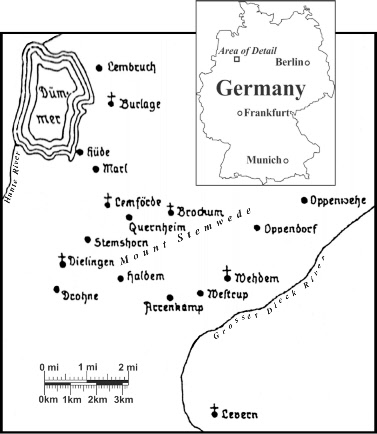
Thereafter the peasant settlements were devoted primarily to making the land productive
so as to provide revenues to support their noble and church landlords. At first,
each village was centered on one peasant and his family, usually called Meyer, following
a Roman model. The Meyer farm became the nucleus of a group of families who farmed
the land, submitted a portion of their produce to the Meyer for safekeeping, and
were then required to assist in transporting it to the landlord. In 1227, the first
mention of Oppenwehe in the documents, four of the farms and the families living
on them were sold by their noble landlord, Helimbert von Manen, to the newly-
We know nothing, unfortunately, about the very earliest Priesmeyers, except that their farm was located on a plain, called the Röhe, from which they acquired an alternate surname, “achter den Röhen,” in use until the early 1600s, when it was fully replaced by Priesmeyer. We cannot even be sure that the Priesmeyers who emerged into the historical record in the early 17th century were direct descendants of the earliest settlers, since, as we’ll see later, surnames initially associated with farms persisted, even if the original settler family died out and was replaced by an entirely new family. But we do know that the Priesmeyer lineage established by about 1570 has been in unbroken possession of the family farm at Oppenwehe 3 until the present and is the origin of nearly all Priesmeyers today.
The earliest farms settled were typically the largest, with between forty and eighty acres, plus access to common grazing land. The soil was sown with various kinds of grain, especially rye, and with grasses for fodder. Each of the large farms had a pair of horses for plowing; several cows, pigs, and sheep; and innumerable geese and chickens. While farming methods cannot be called scientific, the peasants were aware of the value of fertilizing their land and of letting parts of it lie alternatively fallow. Farm houses and barns were not clustered together for protection, as was customary in other parts of Germany, but rather were dispersed in order to be close to the family’s main fields. Farming plots were usually long and narrow, reflecting the relative convenience of plowing without having to turn the team frequently.
Over time, the population of Oppenwehe and of all of the villages in the area grew
and declined in response to the success of harvests and, especially, due to periodic
epidemics. The Black Death of the 14th century devastated large parts of Germany,
but by 1600 the population had reestablished itself to levels reached before the
plague, only to be dealt another massive blow by the Thirty Years War, from 1618
to 1648. The armies of several kingdoms marched and countermarched across central
Europe, pillaging, raping, seizing crops, and killing at will anyone who impeded
their progress. In some parts of Germany as many as two-
As noted above, nearly all of the villages and the constituent farms (and their farming
families) were the property of noble or church landlords. By the late Middle Ages
most of Germany, which was itself divided into many kingdoms and principalities,
had become a patchwork of thousands of intermingled and overlapping landholdings,
as landlords exchanged parts of their properties with each other to settle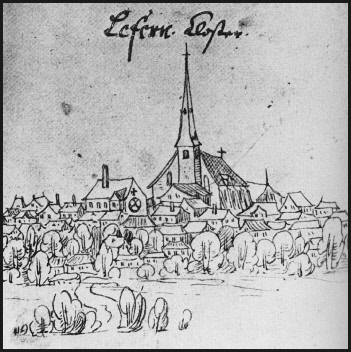 debts,
to fulfill pledges, or, they hoped, to purchase their way into heaven. From 1235,
as we have seen, all of Oppenwehe was the property of the Cistercian convent in Levern,
seven miles to the southwest, as depicted here in the year 1632. From that time forward,
each peasant family was required to submit a portion of its annual produce to the
convent to support the religious community. Even after the Protestant Reformation,
when the convent was converted into a “freiweltliches Dammenstift” -
debts,
to fulfill pledges, or, they hoped, to purchase their way into heaven. From 1235,
as we have seen, all of Oppenwehe was the property of the Cistercian convent in Levern,
seven miles to the southwest, as depicted here in the year 1632. From that time forward,
each peasant family was required to submit a portion of its annual produce to the
convent to support the religious community. Even after the Protestant Reformation,
when the convent was converted into a “freiweltliches Dammenstift” -
When the Priesmeyer name first appeared in written documents, at the beginning of the seventeenth century, the family farm, at Oppenwehe 3, was held by Heinrich Priesmeyer, born in about 1570. As he approached his 60s and retirement, he appealed successfully to his landlord to permit him to pass the family farm to his daughter, Catharine, and to her intended husband, Heinrich Mundt, of Oppenwehe 36. This appeal suggests that she was not the heir originally preferred by Heinrich Priesmeyer and his landlord; rather, the intended heir was probably a son born in about 1605. We don’t know what prevented this son from inheriting, although it may be suggested that he had enlisted for military service during the Thirty Years War and had never returned home.
In any case, Catharine Priesmeyer and Heinrich Mundt were married in 1636 and took
possession of the Priesmeyer farm. In accordance with regional custom, Heinrich adopted
the Priesmeyer surname, and thus it was passed on to their descendants. The couple
had at least five children, and their oldest son, Thomas, born in about 1635, was
eventually chosen to inherit the farm, with the approval of their landlord. As Thomas
approached his marriage, and therefore the receipt of his inheritance, including
the farm, his parents took a relatively unusual step for the time: they established
their two other sons on new farms of their own, carved out of the original family
farm. Normally these sons would have been limited to just a moderate cash bequest
to facilitate marriage to farm-
I Thomas Priesmeyer and my parents declare that we wish to give our sons Gerd Heinrich and Heinrich Priesmeyer each 60 talers in cash from our farm and 6 talers for cattle, and each a horse and a suit of clothes to hold for their wedding day; also to Gerd Heinrich a piece of land of two Scheffelsaat [about two acres] by Johann Spreen’s plot in the Röhe, and to Heinrich two pieces of land of four Scheffelsaat [about four acres] on the Westhoue; and to give the daughter what Marie [Thomas’s fiancée] brings with the dowry; and to pay for a Freibrief [marriage release] or Weinkauf [marriage fee] for the children.
Present as witnesses: Gerd Meyer, Johann Spreen, Johann Bosse.
Oppenwehe, 14 August 1662.
The resulting new farms, which were given the numbers 47 and 50 in Oppenwehe, were
initially quite small, although they grew substantially as later generations added
to them. Thirty years later, Thomas’s oldest son, Martin, born in 1664, also established
a new farm in Oppenwehe, which was given the number 53. Each of the resulting four
Priesmeyer farms in Oppenwehe -
In the census of 1682 we have a snapshot of the first three of the four farms. Oppenwehe
3, headed by Thomas Priesmeyer, which was the original family homestead, was fairly
large, at about 55 acres plus access to common grazing land. Major livestock consisted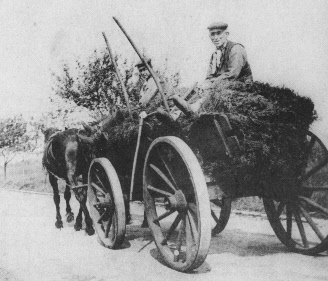 of two horses, four cows, eighteen sheep, and a sow. Each year the family was required
to submit ten percent of their produce to their landlord, Stift Levern, and to provide
transportation to its storehouses. They also owed annual obligations to three separate
civil authorities, Amt Rahden, Amt Levern, and Amt Lemförde. In total, these civil
obligations consisted of another tenth of the produce of their farm, plus several
sheep and hens, a moderate amount of cash, and about ten days of compulsory labor
on roads, public buildings, and transportation.
of two horses, four cows, eighteen sheep, and a sow. Each year the family was required
to submit ten percent of their produce to their landlord, Stift Levern, and to provide
transportation to its storehouses. They also owed annual obligations to three separate
civil authorities, Amt Rahden, Amt Levern, and Amt Lemförde. In total, these civil
obligations consisted of another tenth of the produce of their farm, plus several
sheep and hens, a moderate amount of cash, and about ten days of compulsory labor
on roads, public buildings, and transportation.
The two new family farms, established just a few years before the census, were much smaller. Oppenwehe 47, headed by Thomas’s brother Heinrich, had about four acres, plus access to common grazing land, which was a substantial benefit. Livestock consisted of just two cows. Like their relatives at Oppenwehe 3, they provided ten percent of their crop to Stift Levern and another ten percent to the civil authorities. Other obligations were proportionally smaller, and they were evidently not required to provide personal labor, possibly because they lacked the horses that were often required. The farm at Oppenwehe 50, headed by Thomas’s brother Gerd Heinrich, was even smaller, at about two acres, plus grazing rights. As at number 47, livestock consisted of two cows, and obligations the landlord and civil authorities were similar. Interestingly, both of these small farms were also required to provide a skein of yarn yearly to the sexton of Wehdem Parish, of which Oppenwehe was a part.
LIFE IN A NORTH GERMAN VILLAGE
In 1700 the economy of a typical north German village was based nearly entirely on
peasant families engaged in subsistence farming. Each household, usually consisting
of three generations living in common, was 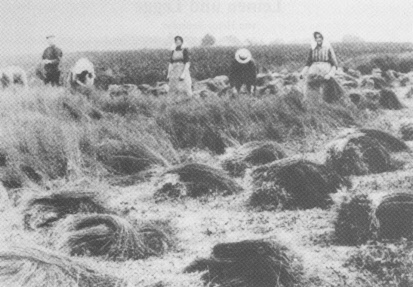 expected to maintain itself on the produce
of its own fields, with enough surplus to meet the relatively moderate exactions
of the landlord and the civil authorities. Because a certain minimum amount of land
was required to meet these demands for a family, it was in the interest of all that
the number of families and households be maintained at a fairly stable level, once
all available land had been occupied.
expected to maintain itself on the produce
of its own fields, with enough surplus to meet the relatively moderate exactions
of the landlord and the civil authorities. Because a certain minimum amount of land
was required to meet these demands for a family, it was in the interest of all that
the number of families and households be maintained at a fairly stable level, once
all available land had been occupied.
In most of northern Germany, population stability was maintained through indivisibility
of farms and limitations on family formation. In each generation, one offspring was
selected to inherit the entire family farm, which was transferred to his or her possession
at the time of marriage. A detailed marriage contract formalized the transfer, contained
guarantees for lifelong maintenance of the retiring parents, and granted a small
living bequest to all other offspring. Ideally, the non-
Occasionally landless men and women were allowed to marry and live as renters and
day-
During periods of population growth, however, there was considerable pressure to
find sufficient land to support additional families. During the 15th and 16th centuries,
as the population recovered from the plagues of the preceding period, new families,
called Markkötter, were gradually accommodated on smaller plots of land, despite
the objections of the older established families, who opposed the increased demands
on common grazing land. Then, in the 16th century, it became necessary to settle
additional new families, often headed by retired soldiers who had been promised land,
on small plots actually carved from the village common and pieced together from inferior
sections; the status of these families is reflected in the term applied to them:
Brinksitzer, literally “brink-
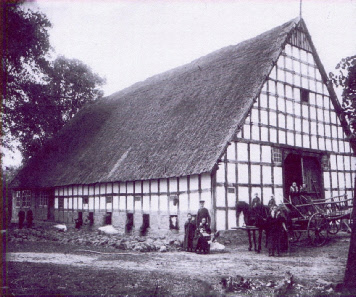 As the area was populated, a distinct hierarchy emerged among the peasant families.
At the top were the long-
As the area was populated, a distinct hierarchy emerged among the peasant families.
At the top were the long-
The remarkable stability and conservatism of the social structure is exemplified by the history of the four established Priesmeyer farms in Oppenwehe. During the five generations between 1680 and 1820, each of the farm families had an average of six children per generation, of whom an average of four survived to adulthood. Of these four, one in each generation was chosen to inherit the family farm, and the other three were married to heirs of other substantial farms in Oppenwehe or nearby villages. Virtually no one left the immediate area, and no one fell out of the landholding class, with one exception, the line that led to the El Campo and Moulton branch, which we’ll examine later.
At the very bottom of the social hierarchy were those without any land -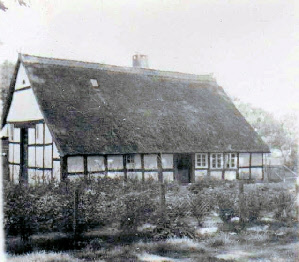 or Häusling (house-
or Häusling (house-
It is important to emphasize that most land-
The peasant’s relationship to his landlord was thus basically feudal, a relic of the Middle Ages. But it was very far from the lord and serf relationship that characterized the large noble estates of East Prussia and Russia. By 1700 in northwest Germany, the landlord was seldom present in the village and often lived at a considerable distance. At least a part of the annual tithe had been converted from a portion of farm produce to a cash payment. It is evident from the documentary record that very few families were ever evicted from their land. In general, the relationship of “dependence” on a landlord was considered desirable. It conferred substantial security and stability of living conditions as well as significant status in the community.
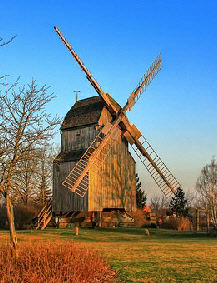 Apart from the landlord, peasant families dealt with a small nucleus of authority
figures. The local Amtshaus -
Apart from the landlord, peasant families dealt with a small nucleus of authority
figures. The local Amtshaus -
It should not be imagined, however, that life was idyllic. Variable weather caused periodic famines, and once every twenty years or so an epidemic of smallpox or dysentery wiped out a large portion of the children and vulnerable old people. Tuberculosis and other bronchial disorders were the scourge of everyone. Medicine was primitive at best, and chronic disabilities were widespread. While midwives were usually quite effective in managing routine pregnancies, a significant number of women died in childbirth. The wooden structures of the village, many of them roofed with thatch, were notoriously vulnerable to fire, and large sections of the village were periodically destroyed in conflagrations.
One feature of peasant culture must be understood as we learn about the Priesmeyers,
and this is the impact of inheritance on naming practices. In pre-
Because the undivided farm was so important to the family through succeeding generations,
the surname assumed by the new generation was that of the heir; if this was a daughter,
her bridegroom assumed her surname, and thus it was passed on to their offspring.
He retained her surname even if she died and he remarried, since it was the name
of the farm, which he still held. Likewise, the widow of a male heir would confer
the surname associated with the farm on her new husband, if she remarried. Finally,
if a farm fell vacant because there was no suitable heir in a particular generation,
the family chosen to take over the farm would adopt the surname associated with the
farm. This custom produces, to the untrained eye, a peculiar-
The population of Oppenwehe and the surrounding area remained relatively stable for the first half of the 18th century. Natural population growth was constrained by periodic epidemics of smallpox and, especially, of dysentery, with two major outbreaks, in 1719 and 1748. But then a steady upward trend began, facilitated by two significant developments: the introduction of smallpox inoculation and the acceptance of the potato as a worthy substitute for bread. The abatement of smallpox naturally enabled a larger proportion of children to survive to adulthood, and the potato, which was roughly five times more nutritionally productive per acre than grains, provided the food to keep the growing population alive.
Still, limited resources, especially land, would have kept a brake on household formation
by restraining 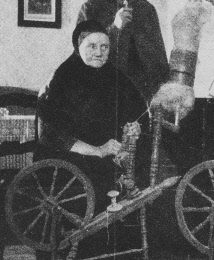 permissions to marry. But a simultaneous development during this period
opened the way for families without land to earn enough to support themselves. This
was the rapidly growing worldwide market for German linen. Peasant families working
in their own homes found that they could spin and weave locally grown flax into high
quality fabric that was in great demand, especially in France and in the expanding
colonies in the Americas. Local markets (Legge) were established that enabled families
to bring their linen for sale and receive compensation in cash. Simultaneously, this
infusion of cash into the economy in general also promoted growth.
permissions to marry. But a simultaneous development during this period
opened the way for families without land to earn enough to support themselves. This
was the rapidly growing worldwide market for German linen. Peasant families working
in their own homes found that they could spin and weave locally grown flax into high
quality fabric that was in great demand, especially in France and in the expanding
colonies in the Americas. Local markets (Legge) were established that enabled families
to bring their linen for sale and receive compensation in cash. Simultaneously, this
infusion of cash into the economy in general also promoted growth.
These three factors -
Then, in the late 1840s, a series of poor harvests placed increasing pressure on everyone. Finally, in 1851, after the opening of the railway from Minden to Cologne, a large mechanized linen spinning mill was constructed in the nearby town of Bielefeld, and the bottom fell out of the market. Landless families who had barely survived by spinning and weaving were driven to the wall.
THE GREAT 19TH CENTURY EMIGRATION
Faced with troubling changes in their environment and dwindling economic resources,
landless peasants throughout Germany began to seek opportunity elsewhere. Those who
lived close to growing cities migrated there and took jobs in the new manufacturing
industries. But those in more isolated areas, like Oppenwehe, began to look abroad
and especially to America. Even the poorest were literate, having been taught to
read in the parish schools, which they had been required to attend until age fourteen.
They read glowing accounts of the New World, such as those of the widely-
The great fertility of the soil, its immense area, the mild climate, the splendid
river connections, the completely unhindered communication in an area of several
thousand miles, the perfect safety of person and property, together with very low
taxes -
Duden thus captured the contrast between life in Germany, where land was expensive (and sometimes unobtainable at any price) and wages were low, and life in America, where land was abundant and inexpensive and labor was in demand. Simultaneously, local and state governments in America, seeking to attract industrious settlers on the expanding frontier, published brochures and commissioned recruiters in Germany. Merchants, who were then importing cotton and other raw materials from America and sending ships back only partly loaded, learned that they could fill their holds with emigrants by offering attractive fares. When the seaports of northern Germany, particularly Hamburg and Bremen, observed the prosperity that was accruing to the French and Dutch ports as they served transiting emigrants, they moved quickly to invest in infrastructure and dispatched agents to encourage departing families to choose them for their voyage.
During the nineteenth century, nearly five million Germans came to live in America.
After 1845 yearly totals usually exceeded 100,000, except for the years of the U.S.
Civil War. Both individuals and families came, and with rare exceptions their motives
were entirely economic: to escape the dwindling opportunities in their homeland to
earn their share of the prosperity of the growing nation. They were usually not entirely
destitute but rather had carefully husbanded their resources in Germany and came
with enough money to get started, whether in a town or on a farm. In general, they
were devoted to family and community, calmly religious, frugal, industrious, and
reasonably well educated. Their goals were markedly conservative: they hoped to recreate
the world that they believed that their grandparents had enjoyed -
This is the classic story of the great German immigration to America in the nineteenth century. As we will see in the following section, it describes an important portion of the Priesmeyers, primarily those who settled in Texas. But the majority of the Priesmeyer immigrants were evidently moved by a somewhat different set of considerations. While they too sought the comparative benefits of the expanding American economy, they were not drawn to the conservative vision of a life devoted to the rural environment and farming. Instead, they chose to settle in the rapidly growing cities of the Midwest, primarily St. Louis. Their goal was not to accumulate the resources to purchase a farm but rather to explore their opportunities in the urban environment, first as craftsmen and laborers and then as investors in their own businesses. While they remained conservative in their devotion to family, religion, and community, their economic outlook was distinctly progressive.
While we cannot know for certain why so many Priesmeyer immigrants chose to settle
and work in cities, one key factor in their background may explain most of their
motivation. As we will see below, the dominant figure in the development of the branch
of Oppenwehe 47 -
It is quite likely that Johann Friedrich’s descendants were influenced by his example
and may have been attracted to commerce by their involvement in the family businesses.
Most important, it is evident that Johann Friedrich began a family custom of requiring
his non-
Twenty male descendants of Johann Friedrich Priesmeyer emigrated to America between 1848 and 1923, nineteen of whom lived long enough to establish themselves in their occupations. Twelve settled in or near St. Louis, three in Cleveland, two in Chicago, one in Fort Wayne, and one in Garwood, Texas (after settling initially in St. Louis). Only one took up farming, near St. Louis. The others, having typically begun as common laborers, ultimately established themselves as manufacturers, wholesalers, merchants, grocers, and retailers. Several amassed considerable wealth and became pillars of the community.
St. Louis held a special attraction for these industrious immigrants. Drawn by the commentary of Gottfried Duden in the 1820s, as noted above, Germans flocked to the growing city. With just 25,000 inhabitants in 1840, it tripled in population over the next ten years; half of the increase consisted of German immigrants. As noted by historian Walter Kamphoefner,
Since mid-
As the following family stories reveal, the immigrants who settled in St. Louis and other cities acclimatized and modernized rapidly, while their farming cousins in Texas remained true to rural traditions and values for at least another generation if not more. Most notably, the urban Priesmeyers had fewer children, who resided longer with their parents, married late, and themselves had small families. They often gave their children anglicized names and were willing to explore their options in the diverse religious environment of their new country. By contrast, the rural Priesmeyers married early and had large numbers of children, whom they gave traditional German names. They normally remained faithful to their Lutheran faith for several generations unless they married someone of a different religion, especially a Roman Catholic.
Consequently, while the branch of Oppenwehe 47 provided more than half of the male
immigrants, who quickly urbanized, their descendants today make up a relatively small
part of the Priesmeyers living in America. Instead, well over half of today’s Priesmeyers
descend from just two young brothers, born in poverty a few miles from Oppenwehe,
who settled in east Texas (El Campo and Moulton) in 1860 and took up farming. Although
they too were descendants of Oppenwehe 47, their line had broken away 150 years earlier
and had become landless and poor. By the time the two branches -
PRIESMEYER IMMIGRANTS TO AMERICA
The following sections explore the fortunes of the various immigrant Priesmeyer branches. You may wish to skip ahead to your own branch, but it is hoped that you will also enjoy reading about the experiences of your cousins in the other branches. Because the narrative may be difficult to follow, especially if you are seeking your own ancestor, two summary aids have been prepared. The first is a list of all 46 immigrants in the order of their year of departure from Germany, with their dates and locations of birth, marriage, and death. Particularly helpful may be the entry immediately after the full German name that gives the name that the immigrant used in America, which was often anglicized. The second aid is a summary chart of the various Priesmeyer branches and their ultimate destinations in America. Please contact the author if you need assistance.
The Priesmeyers of Oppenwehe 47: the Midwest, and Garwood, Texas
The first generation on the new farm at Oppenwehe 47 exemplified the struggles of the family as they established themselves. Heinrich Priesmeyer and his wife Anne Alheit Hilmer, who married in 1665, began with a very small plot, as we saw above in Thomas Priesmeyer’s 1662 marriage addendum. Yet they laid a solid foundation for future generations by adding steadily to their holdings. Their primary task was to ensure a successful transition to the next generation, and they chose their oldest son, Johann Heinrich, born in 1668, to be their heir. He took over the farm at the time of his marriage, in 1692, to Catharine Elisabeth Battenhorn of Rahden, permitting his parents to retire to a cottage near the family home.
Or at least that was the plan. As it turned out, the erstwhile retirees were not happy with their son and his new wife. In November 1692 they submitted an agreement to their landlord in Levern:
Whereas Heinrich Priesmeyer of Oppenwehe and his wife Anne Alheit [Hilmer] recently handed over their small farm to their son Johann Heinrich and his wife Catharine Elisabeth Battenhorn, but they now find that they cannot reconcile and agree with them, they have today reserved for themselves the following instead of retiring:
1. The rye field to the west of the house;
2. A cabbage patch in the garden in Martin Holle’s field;
3. An average-
4. A breeding goose, which, along with the cow, the young couple will feed and care for;
5. ____ The great kettle to be reserved for their use as often as it might be needed, without any objection or impediment;
6. It is agreed and decided that the other two sons and three daughters, rather than
awaiting their inheritance, will each immediately have fifteen talers, a half-
Everyone was satisfied with this agreement and promised to live in peace and harmony.
As can be seen from this document, the parents did as much as they could for their
other five marriageable children. While they were all eventually married to farm
heirs -
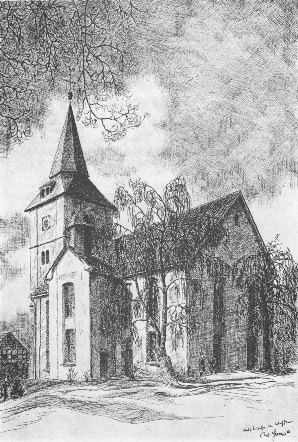 The next generation at Oppenwehe 47, led, as we saw above, by heir Johann Heinrich
Priesmeyer, born in 1668, continued the development of the farm, but finding spouses
for the children remained a challenge. Apart from the heir, Johann Hermann, born
in 1697, the other three surviving children married to small farms at a relatively
advanced age. Then, with Johann Hermann’s generation, misfortune befell the line.
He took over the farm in 1723, at the time of his marriage, but he lived barely five
more years, leaving his widow and a daughter, Marie Catharine, born in 1729 after
his death, who became by default the eventual heir to the farm. In 1753 Marie Catharine
married Hermann Heinrich Marcus of Oppenwehe 46, and they took over the farm at that
time. In accordance with regional custom, Hermann Heinrich assumed the Priesmeyer
surname, and thus it was passed on to their descendants. It is evident that the farm
prospered under their management; their three surviving children all married well,
including their chosen heir, Johann Friedrich, born in 1764.
The next generation at Oppenwehe 47, led, as we saw above, by heir Johann Heinrich
Priesmeyer, born in 1668, continued the development of the farm, but finding spouses
for the children remained a challenge. Apart from the heir, Johann Hermann, born
in 1697, the other three surviving children married to small farms at a relatively
advanced age. Then, with Johann Hermann’s generation, misfortune befell the line.
He took over the farm in 1723, at the time of his marriage, but he lived barely five
more years, leaving his widow and a daughter, Marie Catharine, born in 1729 after
his death, who became by default the eventual heir to the farm. In 1753 Marie Catharine
married Hermann Heinrich Marcus of Oppenwehe 46, and they took over the farm at that
time. In accordance with regional custom, Hermann Heinrich assumed the Priesmeyer
surname, and thus it was passed on to their descendants. It is evident that the farm
prospered under their management; their three surviving children all married well,
including their chosen heir, Johann Friedrich, born in 1764.
Johann Friedrich Priesmeyer began a new and impressive era in the history of Oppenwehe
47. At the time of his marriage in 1789, he was a soldier, in the 2nd battalion of
the Prussian Royal Grenadier Guard in Potsdam. After military service, he returned
to Oppenwehe and assumed control of the family farm. In addition to increasing his
landholdings, he established an inn and tavern, which became the center of community
life in Oppenwehe. We can be certain that his wife, Marie Elisabeth Röhling of Oppenwehe
29, was just as remarkable, having supported his endeavors while giving birth to
ten children, including a set of triplets and a set of twins. (Unfortunately, the
churchbook says relatively little about the women of the parish.) When Johann Friedrich
died, in 1835, the pastor noted prominently in the churchbook that Johann Friedrich
had been a “churchwarden, businessman, and farm holder.” Most important for our story,
twenty-
The next generation was headed by Johann Friedrich’s and Marie Elisabeth’s son, Christian
Friedrich, born in 1801. With his generation, conditions had begun to change rapidly
in the region. Land reforms were leading to consolidation of peasant farms and enclosure
of common pasturage, undermining the traditional structures of subsistence farming
and reducing the amount of available land for new farms. But the population continued
to grow, and opportunities to establish traditional landholding marriages and households
steadily diminished. While Christian Friedrich was able to provide the well-
Johann Heinrich Wilhelm Priesmeyer, born in 1825
Emigrated in 1848, probably to Cincinnati
Evidently died shortly after arrival in America
Johann Christoph Gottlieb Priesmeyer, born in 1827
Emigrated in 1848 to Cincinnati and settled in St. Louis
Occupation: bricklayer
Married Caroline Wilhelmine Henriette Spreen of Westrup in 1851
Child:
Heinrich Friedrich Priesmeyer, born in 1856 in St. Louis
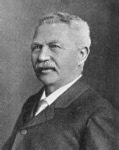 Heinrich Wilhelm August Priesmeyer, born in 1832
Heinrich Wilhelm August Priesmeyer, born in 1832
Emigrated in 1849 to Cincinnati and settled in St. Louis
Occupation: shoemaker, then major shoe manufacturer
Married Caroline Steinbrügge of Hannover in 1860
Child:
Edward Priesmeyer, born in 1867 in St. Louis (died in 1871)
Johann Friedrich Carl Priesmeyer, born in 1838
Emigrated in 1857 to St. Louis
Occupation: confectioner
Married Louise Steinbrügge of Hannover in 1865
Children:
Charles J. Priesmeyer, born in 1867 in St. Charles, Missouri
Alvina Priesmeyer, born in about 1868 in St. Charles, Missouri
August E. Priesmeyer, born in 1870 in St. Louis
Ida Priesmeyer, born in 1872 in St. Louis
Christian Friedrich’s brother, Johann Heinrich, born in 1790, married in 1818 and founded a small new farm in Oppenwehe, which was given the number 70. Three of his five surviving children emigrated to America:
Carl Friedrich Wilhelm August Priesmeyer, born in 1824
Emigrated in 1854 to St. Louis and settled in Chicago
Occupation: baker
Married Margarethe Wolf of Hesse Darmstadt in 1860
Children:
Edward August Gottlieb Priesmeyer, born in 1861 in St. Louis
Emma Priesmeyer, born in about 1866 in Chicago
Augusta Priesmeyer, born in 1870 in Chicago
Anna Priesmeyer, born in 1871 in Chicago
Albert A. Priesmeyer, born in 1873 in Chicago
Matilda Priesmeyer, born in 1877 in Chicago
Hattie Priesmeyer, born in about 1880 in Chicago
Dollie Priesmeyer, born in 1883 in Chicago
Doris B. Priesmeyer, born in about 1887 in Chicago
Heinrich Friedrich Priesmeyer, born in 1831
Emigrated in 1851 to St. Louis
Occupation: grocer, then chemical merchant
Married Anne Marie Gaus of Prussia in 1860
Children:
Johann Heinrich Wilhelm Priesmeyer, born in 1860 in St. Louis
Christian Julius Priesmeyer, born in 1863 in St. Louis
Matilda Anna Priesmeyer, born in 1865 in St. Louis
August Friedrich Gottlieb Priesmeyer, born in 1834
Emigrated in 1852 to St. Louis and settled in Chicago
Occupation: grocer, teamster, policeman, coal merchant
Married Christine Wolff of Hesse in 1860
Children:
August Gustave Priesmeyer, born in 1860 in St Louis
August Heinrich Priesmeyer, born in 1861 in Chicago
Johann Friedrich Priesmeyer, born in 1863 in Chicago
George Louis Priesmeyer, born in 1868 in Chicago
Mary Priesmeyer, born in 1869 in Chicago
Frank Adam Priesmeyer, born in 1872 in Chicago
Emma Priesmeyer, born in 1878 in Chicago
Charles Priesmeyer, born in about 1880 in Chicago
Emily H. Priesmeyer, born in about 1882 in Chicago
Lillian Priesmeyer, born in 1883 in Chicago
Another of Christian Friedrich’s brothers, Johann Christoph, born in 1796, founded a small new farm in the neighboring village of Oppendorf, which was given the number 107. Of his eight surviving children, five emigrated to America:
Heinrich Friedrich Wilhelm Priesmeyer, born in 1821
Emigrated in 1848 to Cincinnati and settled in St. Louis
Occupation: bricklayer
Married Anne Marie Kicke of Westphalia in 1852
Children:
Heinrich Wilhelm Priesmeyer, born in 1856 in St. Louis
Caroline Priesmeyer, born in about 1858 in St. Louis
Louise Charlotte Friederike Priesmeyer, born in 1826
Emigrated in 1846 to St. Louis
Married Johann Christoph Schumacher of Westrup in 1846
Marie Wilhelmine Caroline Priesmeyer, born in 1928
Emigrated in 1852 to St. Louis
Married Gerhard Heinrich Luke of Germany in 1853
Charlotte Wilhelmine Henriette Priesmeyer, born in 1830
Emigrated in 1847 to St. Louis and settled in Quincy, Illinois
Married Dietrich Schmidt of Germany in 1849 and then Franz Heinrich Wittler of Hannover in 1853
Johann Friedrich Wilhelm Priesmeyer, born in 1835
Emigrated in 1852 to St. Louis
Occupation: farmhand, then laborer
Married Louisa Knepper of Hannover in 1868
Children:
Amalia Priesmeyer, born in about 1869 in St. Louis
Frederick W. Priesmeyer, born in 1873 in St. Louis
Yet another brother of Christoph Friedrich, Friedrich Wilhelm, born in 1798, acquired an existing farm at Oppendorf 99. Six of his eight surviving children emigrated to America:
Christoph Wilhelm August Priesmeyer, born in 1832
Emigrated in 1850 to St. Louis
Occupation: butcher
Married Elizabeth of Missouri in about 1854
Children:
Caroline Priesmeyer, born in about 1855 in St. Louis
William H. Priesmeyer, born in 1859 in St. Louis
Lena Priesmeyer, born in about 1863 in St. Louis
Henry E. Priesmeyer, born in 1866 in St. Louis
Edward T. Priesmeyer, born in 1874 in St. Louis
Henriette Wilhelmine Caroline Priesmeyer, born in 1838
Emigrated in 1859 and settled in Staunton, Illinois
Married Wilhelm Meyer of Braunschweig in 1862
Christoph Friedrich Wilhelm Priesmeyer, born in 1842
Emigrated in 1867 and settled in Madison County, Illinois
Occupation: farmer
Married Sophia Bartmann of Prussia in 1874
Children:
Henriette Louise Caroline Priesmeyer, born in 1875 in Staunton, Illinois
Anne Christine Caroline Priesmeyer, born in 1878 in Staunton, Illinois
Ernst Carl William Priesmeyer, born in 1880 in Madison County, Illinois
Fredericka Priesmeyer, born in 1882 in Madison County, Illinois
Mathilda Sophia Priesmeyer, born in 1883 in Madison County, Illinois
Lydia Priesmeyer, born in 1887 in Madison County, Illinois
Frederick Priesmeyer, born in 1895 in Madison County, Illinois
Carl Friedrich Wilhelm Priesmeyer, born in 1844
Emigrated in 1866 to St. Louis
Occupation: coal merchant
Married Christine Schumacher of Westphalia in 1874
Children:
Anne Henriette Priesmeyer, born in 1874 in St. Louis
Carl Friedrich Wilhelm Priesmeyer, born in 1876 in St. Louis
Mathilde Wilhelmine Caroline Priesmeyer, born in 1878 in St. Louis
Caroline Priesmeyer, born in 1881 in St. Louis
Charles S. Priesmeyer, born in 1884 in St. Louis
Henriette Wilhelmine Caroline Priesmeyer, born in 1845
Emigrated in 1860 and settled in Staunton, Illinois
Married Heinrich Wilhelm Hiffmann of Westphalia in 1864
Eight children
Heinrich Wilhelm Priesmeyer, born in 1847
Emigrated in 1866 to St Louis
Occupation: chemical merchant
Married Anne Marie Gaus (widow of his cousin Heinrich Friedrich Priesmeyer) in 1872
Child:
Frederick W. Priesmeyer, born in about 1872 in St. Louis
In summary, from the pivotal household of Johann Friedrich Priesmeyer and Marie Elisabeth
Röhling at Oppenwehe 47, eighteen grandchildren emigrated to America between 1846
and 1866 -
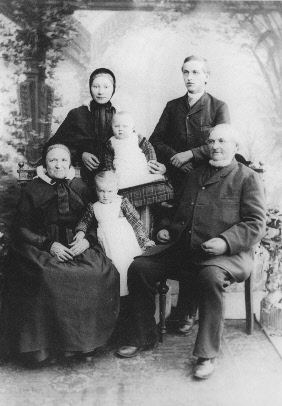 Continuing on to the following generations of the main-
Continuing on to the following generations of the main-
Carl Christian Friedrich Priesmeyer, born in 1854
Emigrated in 1872 to St. Louis and eventually settled in Indianapolis
Occupation: shoe salesman, then bookkeeper
Married Clotilde Zuendt of Wisconsin in 1881
Children:
Irma Jeanette Priesmeyer, born in 1882 in Missouri
Venita C. Priesmeyer, born in 1884 in Jefferson City, Missouri
Alice Priesmeyer, Born in 1887 in St. Louis
Jeanette Mildred Priesmeyer, born in 1889 in Missouri
William Albert Priesmeyer, born in 1892 in Missouri
Another of Bernhard Heinrich Wilhelm’s brothers, Christian Friedrich Wilhelm Priesmeyer, born in 1856, married Henriette Wilhelmine Caroline Schröder, heir to her family’s farm at Oppendorf 21. Four of their five surviving children emigrated to America:
Christian Friedrich Wilhelm Priesmeyer, born in 1878
Emigrated in 1893 to Fort Wayne, Indiana, and eventually settled in Texas
Occupation: laborer, then real estate agent
Married Emma Helen Weimar of Dashwood, Ontario, in 1909
Children:
Carl W. Priesmeyer, born in 1910 in Allen County, Indiana
William Weimar Priesmeyer, born in 1912 in Rock Island, Texas
Cordelia Priesmeyer, born in 1916 in San Antonio, Texas
Henriette Caroline Wilhelmine Priesmeyer, born in 1883
Emigrated in 1905 to Bangor, Pennsylvania; then to Rock Island, Texas; and eventually settled in Norwalk, California
Married John M. Bender in about 1908
Without children
Heinrich Friedrich Priesmeyer, born in 1885
Emigrated in 1901 to St. Louis and settled in Garwood, Texas
Occupation: shoe salesman, then proprietor of a chain of general stores
Married Clara Marie Beck in 1910
Children:
Edward William Priesmeyer, born in 1911 in Rock Island, Texas
Alice Wilhelmina Anna Priesmeyer, born in 1913 in Yoakum, Texas
Frederick Beck Priesmeyer, born in 1921 in Garwood, Texas
William Xavier Priesmeyer, born in 1922 in Garwood, Texas
Wilhelmine Louise Priesmeyer, born in 1897
Emigrated in 1923 to Houston, Texas
Married Henry A. Schade in 1928
Along another line originating at Oppenwehe 47, we have already seen above that Johann Christoph Priesmeyer, born in 1796, established a new farm at Oppendorf 107 and sent five children to America. His son Carl Friedrich Wilhelm Priesmeyer, born in 1824, inherited the farm in 1848. From his three marriages, three children emigrated to America:
Christoph Friedrich Wilhelm Priesmeyer, born in 1849
Emigrated in 1864 to Cleveland
Occupation: grocer
Married Rosina Hermann of Bavaria in 1875
Without children
August Christoph Wilhelm Priesmeyer, born in 1865
Emigrated in 1881 to Cleveland
Occupation: butcher and grocer
Married Wilhelmine Huy of Cleveland in 1889
Children:
Irene M. Priesmeyer, born in 1892 in Cleveland
Walter C. Priesmeyer, born in 1894 in Cleveland
Carl Friedrich Wilhelm Priesmeyer, born in 1868
Emigrated in 1882 to Cleveland and eventually settled in Randolph County, Missouri
Occupation: pharmacist
Married Bee Elliott of Missouri in 1896
Child:
Friederika Priesmeyer, born in Missouri in 1901
In the next generation at Oppendorf 107, the heir, August Friedrich Wilhelm, born in 1873, sent one child to America, who was the last of all the Priesmeyer emigrants:
Carl Theodor Priesmeyer, born in 1905
Emigrated in 1923 to Cleveland
Occupation: salesman, then branch manager for a beer importer
Married Dorothy Esther Zielke of Cleveland in 1931
Children:
Ellen Louise Priesmeyer, born in about 1937 in Cleveland
Carla Priesmeyer, born in 1939 in Cleveland
Today the main Priesmeyer lineage of Oppenwehe 47/Oppendorf 97 (modern address Oppendorfer
Strasse 1) -
Yet the descendants of this main branch do not today comprise the largest group of Priesmeyers in America. That distinction is held by the branch (also originating at Oppenwehe 47) that we will consider next, that of El Campo and Moulton, Texas. This branch sent only two emigrant brothers to America, in 1860, yet today its descendants substantially outnumber those of the Midwest branch. Why? Because most of the 27 immigrants of the main Oppenwehe 47 branch settled in cities and urbanized quickly. They had small families, and their children married late and also had small families. By contrast, the El Campo and Moulton immigrants were struggling farmers who married early and had large families, as did their children and grandchildren.
The Priesmeyers of Oppenwehe 47: El Campo and Moulton, Texas
The most numerous of the Priesmeyer branches in America today also has the most distinctive
history. It was the earliest lineage -
We have already seen that Heinrich Priesmeyer and Anne Alheit Hilmer founded a new
farm at Oppenwehe 47 in 1665 and that they selected their oldest son, Johann Heinrich,
born in 1668, to inherit the farm. Johann Heinrich’s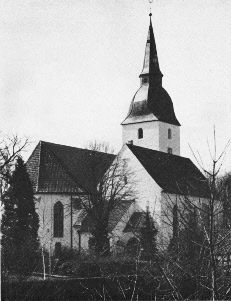 younger brother, Gerd Heinrich,
born in 1670, was left with just a small endowment to facilitate his search for a
bride. Since he was not wealthy, he was undoubtedly fortunate to become engaged,
at the relatively advanced age of 34, to Agnese Platine Engelken, just 19 years old
and heir to her family’s small farm, number 44, in the nearby village of Levern.
So slight were his resources that his more fortunate brother Johann Heinrich paid
the required five taler fee to their landlord for his permission to marry, called
the Weinkauf.
younger brother, Gerd Heinrich,
born in 1670, was left with just a small endowment to facilitate his search for a
bride. Since he was not wealthy, he was undoubtedly fortunate to become engaged,
at the relatively advanced age of 34, to Agnese Platine Engelken, just 19 years old
and heir to her family’s small farm, number 44, in the nearby village of Levern.
So slight were his resources that his more fortunate brother Johann Heinrich paid
the required five taler fee to their landlord for his permission to marry, called
the Weinkauf.
In accordance with regional custom, Gerd Heinrich adopted the Engelken surname at
marriage, when he and his bride took possession of her farm. They had seven children
between 1708 and 1726, all of whom survived to adulthood. Ultimately they passed
their farm at Levern 44 to one of their older sons, Johann Heinrich, when he married
in 1733, and then applied themselves, as did all good land-
Most important for our history, they were unable to provide a sufficient endowment
to their son Christoph Friedrich, born in 1718. 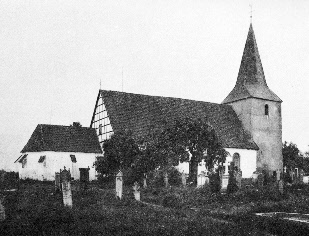 He evidently moved in his teens to
the nearby village of Marl and worked as a day-
He evidently moved in his teens to
the nearby village of Marl and worked as a day-
Friedrich and Engel Priesmeyer (as they were called) established themselves in a
laborer’s cottage in nearby Dielingen Parish, first in the village of Haldem and
then at the Blumenhorst farm at Arrenkamp 13, finally settling at the Wellmann farm
at Arrenkamp 11. Here they undoubtedly worked as day-
Four of their seven children were daughters, and all four were in their 30s before
marrying landless laborers; more significant, among them they had a total of at least
five children out of wedlock before their marriages. We can be sure that their parents
were mortified by this behavior, but in the environment of rural 18th century Germany
they, as a family living in poverty, could do little to discourage or prevent it.
Their three sons were nearly as luckless as their daughters: only one succeeded in
marrying and having children -
Like his father, as a young man Johann Hermann Priesmeyer moved north to the nearby village of Marl, where he obtained work on the Fyhe farm, at Marl 7. At the age of nineteen he enlisted in the Hanoverian army and was a private in the 1st company, 2nd battalion, 2nd infantry regiment when, in June 1783, he was granted permission to leave the army. In 1779 he had married Anne Sophie Lucie Meyer of Marl, 24 years old and six weeks pregnant. (Interesting sidelight: Ms. Meyer provides, in her family tree, the earliest documented ancestor of all of the Priesmeyer branches: Eggert zum Mohr, born in about 1470 at Marl 6.) They had five children, only two of whom survived to adulthood.
In 1810 the older of the two children, Johann Friedrich, born in 1779, married Anne
Marie Lucie Luther of Marl, and they settled in a laborer’s cottage; initially they
had just one cow, one calf, two pigs, one gander, two geese, and no horses or beehives.
In 1811, however, they received a bit of good luck: they were invited 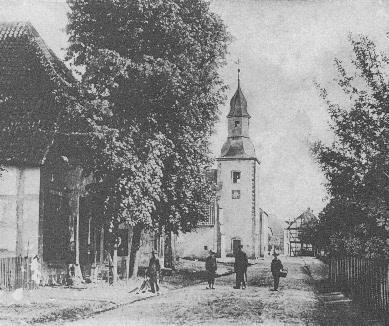 to take over
the farm of the Buck family (1st cousins of Johann Friedrich’s wife) at number 18
in the neighboring village of Quernheim. Unfortunately, the farm was in bad condition,
and they had to invest nearly 500 talers to restore the “dilapidated” house and to
return the land to productivity. Here they had six children, four of whom survived
to adulthood. Although they had a farm of their own, it was so small that they continued
to work as day-
to take over
the farm of the Buck family (1st cousins of Johann Friedrich’s wife) at number 18
in the neighboring village of Quernheim. Unfortunately, the farm was in bad condition,
and they had to invest nearly 500 talers to restore the “dilapidated” house and to
return the land to productivity. Here they had six children, four of whom survived
to adulthood. Although they had a farm of their own, it was so small that they continued
to work as day-
Nevertheless it is evident that the industriousness of the family enabled them gradually to build their farm at Quernheim 18. As their heir, Johann Friedrich and Anne Marie Lucie chose the younger of their two sons, Johann Friedrich, born in 1822, who continued to build the farm and in about 1875 passed it on to his heir. A map of 1870 shows that by that year several large plots of land had been added to the original holdings.
Their older son, Heinrich Georg Ludwig Priesmeyer, born in 1815, became a day-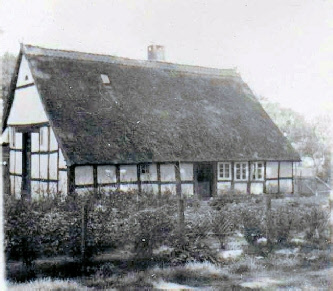 next nineteen years in a laborer’s cottage on the property
of the Nobbe family at Quernheim 5. By a stroke of good fortune, a photograph of
this cottage was taken in about 1960, just before it was torn down, and the photograph
has survived. It shows a thatched Fachwerk (half-
next nineteen years in a laborer’s cottage on the property
of the Nobbe family at Quernheim 5. By a stroke of good fortune, a photograph of
this cottage was taken in about 1960, just before it was torn down, and the photograph
has survived. It shows a thatched Fachwerk (half-
In this cottage, Heinrich and Sophie had two sons, Hermann Friedrich Heinrich, born in 1842, and Heinrich Hermann Friedrich, born in 1845. The parents worked hard to make ends meet, often in difficult economic times; they worked in the fields and probably also spun and wove linen in their small home. Their sons attended school, and we know from their report cards that Heinrich was the better student (good in bible studies, very good in reading and writing).
By the early 1850s, however, after several bad harvests and the collapse of the market for handwoven linen, they were finding it progressively harder to survive. While they could have persisted and scraped by, as did many of their peers, they began to consider the possibility of going to America. Their interest was whetted by letters sent from recent emigrants from their area describing the opportunities in the United States. Most important, two of Sophie’s younger sisters, Charlotte and Louise, had already emigrated to Frelsburg, Texas, where they had married and established prosperous households. They undoubtedly wrote encouraging letters to Sophie, which evidently settled the matter.
As soon as son Heinrich was confirmed, in 1860, the family gathered together their
possessions and departed for America. Because Heinrich was considered a potential
inductee into the Hanoverian army and therefore normally prohibited from emigrating,
their pastor prepared a transcript of his baptism record that declared  that he was
three years younger than his actual age, enabling the family to slip past government
officials.
that he was
three years younger than his actual age, enabling the family to slip past government
officials.
On September 20, 1860, the family of four boarded the brig “Weser” in Bremerhaven. They were accompanied by Henriette Köster, from the nearby village of Westrup, who would soon marry the older Priesmeyer son, Friedrich. They were also joined by their neighbors from Quernheim, Friedrich and Charlotte Meyer with their infant son Heinrich, who would eventually marry the Priesmeyers’ first grandchild, Sophie. After a nine week voyage they landed in Galveston, on November 23, and embarked on the arduous trek to Frelsburg, 130 miles to the west.
In 1860 Frelsburg was a prosperous German community that had been founded over twenty
years earlier. It already had several hundred inhabitants, a post office, two churches,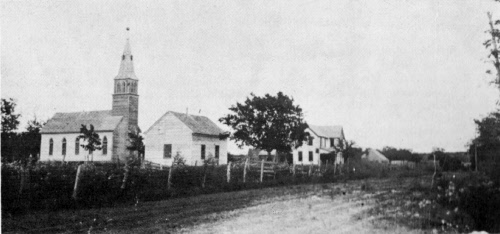 two general stores, two blacksmiths, a cobbler, and a cotton gin. The photograph
reproduced here shows the main street in the 1800s, dominated by Trinity Lutheran
Church, where the Priesmeyers’ sons would eventually be married. It’s likely that
Sophie and the two boys reached Frelsburg by Christmas, but evidently Heinrich (the
father) died soon after arriving in Galveston and may never have seen the promised
land.
two general stores, two blacksmiths, a cobbler, and a cotton gin. The photograph
reproduced here shows the main street in the 1800s, dominated by Trinity Lutheran
Church, where the Priesmeyers’ sons would eventually be married. It’s likely that
Sophie and the two boys reached Frelsburg by Christmas, but evidently Heinrich (the
father) died soon after arriving in Galveston and may never have seen the promised
land.
The family arrived at a difficult time in America. Just five months later the forces of the Confederacy bombarded Fort Sumter, and the country was embroiled in four years of bitter civil war. While son Heinrich avoided conscription by the Confederate army, Friedrich was not so fortunate. In June 1863 he was drafted and assigned to Company H of the 17th Texas Infantry, at Camp Terry, in Austin. While he probably missed the battle of Milliken’s Bend in that month, a Union victory in which the 17th suffered 86 casualties, he evidently was with his unit campaigning in Louisiana the following November, when he was taken prisoner by Union forces. Declaring himself a deserter from the Confederate army, Friedrich then enlisted (perhaps not entirely voluntarily) in Company A of the 1st Regiment of the New Orleans Infantry of the U.S. Army, which was evidently assigned mainly to garrison and guard duty in New Orleans. At the end of the War, in 1865, like so many soldiers he simply left for home and later in life was absolved of all charges of desertion.
The two brothers established themselves in Texas:
Hermann Friedrich Heinrich Priesmeyer, born in 1842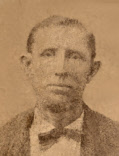
Emigrated in 1860 to Frelsburg, Texas; later lived in Moulton, Texas
Occupation: farmer
Married Henriette Wilhelmine Caroline Köster of Westrup in 1861
Children:
Henrietta Sophia Dorothea Priesmeyer, born in 1862 in Frelsburg
Maria Adolphina Bertha Priesmeyer, born in 1867 in Frelsburg
Heinrich Gerhard Daniel Priesmeyer, born in 1869 in Frelsburg
Friedrich Ignatz Gerhard Priesmeyer, born in 1871 in Frelsburg
Henrietta Charlotta Meta Priesmeyer, born in 1874 in Frelsburg
Wilhelm Friedrich Karl Priesmeyer, born in 1876 in Frelsburg
Heinrich Johann Priesmeyer, born in 1878 in Flatonia
Ida Louise Katharina Priesmeyer, born in 1862 in Moulton
Heinrich Hermann Friedrich (Henry) Priesmeyer, born in 1845
Emigrated in 1860 to Frelsburg, Texas; children settled in El Campo, Texas
Occupation: farmer
Married Adolphine Gerhardine Sophie Becker in 1870
Children:
August Friedrich Priesmeyer, born in 1870 in Frelsburg
Theodore Gerhardt Priesmeyer, born in 1872 in Frelsburg
Meta Priesmeyer, born in 1874 in Fayette County
Louisa Maria Sophia Priesmeyer, born in 1877 in Fayette County
The two brothers worked as tenant farmers and struggled to support their families. The character of their lives is captured in an anecdote told by Friedrich’s granddaughter, Henrietta Meyer: “When Sophie [Friedrich’s daughter, born in 1862] was seven years old her dad was a Texas trail driver delivering flour. He had four horses pulling the wagon and two rest horses following. He was constantly having a high fever. Sophie would go along and bathe his head with cool river water.”
Both brothers died young and without significant wealth. Friedrich’s widow struggled to support her large family in Moulton. While she was able to purchase a small plot of land that she let to sharecroppers, it is evident that her resources always remained small. Heinrich’s widow married Frederick Lillie, in whose household her four children were raised. Many of the brothers’ children had large families, and today their descendants account for over half of all Priesmeyers in America, even though they were just two of the 46 Priesmeyer emigrants who came to America.
What about the branch of the family who stayed behind in Germany? It was initially headed by Johann Friedrich Priesmeyer, born in 1822, Heinrich Georg Ludwig’s younger brother, who was heir to the family farm at Quernheim 18. The farm was eventually passed to his grandson, Friedrich Heinrich Hermann, born in 1890. Heinrich excelled in schoolwork, finishing at the top of his elementary school class. By the time of his graduation, in 1905, his father and only sister were deceased, and his mother died soon thereafter, in 1906. Heinrich decided to sell the farm and study to become a teacher.
By 1934 Heinrich was the schoolmaster of the village of Holtensen and a staunch Nazi. In that year he published a long article about the rise of the Hitler Youth in his district. Here’s how he began:
“Young people! We are the soldiers of the future.
“Young people! Bearers of destiny.
“Hearts beat faster and the future is full of hope when we see our young boys marching, clad in brown and black. In sturdy hobnailed boots, a war chant on their lips, with their banners held high, they march in lockstep on forest paths and on broad highways. Determination inspires them, and they are driven to their goal. In every German province this is the scene. Young Germans are awake and ready to fulfill their profound duty now and forever.
“Under the great Nazi system, the Hitler Youth has set the ambitious goal of molding all of the boys and girls of Germany into a national movement, as the Führer wishes. The Hitler Youth proudly claims to be the one and only correct form of National Socialism for the young generation. It has thus assumed primary responsibility, with zeal and the will to fight, for the achievement of this great task, as set by the Führer himself.”
He then presented a lengthy narrative of the growth of the Hitler Youth, concluding:
“At the Party Convention in Hannover in 1934, 4,500 youth leaders from all of Lower Saxony, including boys and girls from our district, filled the huge rotunda of the city hall. They were aware of the significance of this event, forging the unbreakable unity of the youth of Lower Saxony. As the organ powerfully intoned variations on ‘Our Flag Waves above Us’ and as the chairmen spoke, everyone experienced the greatness made possible only by solidarity with the concept of the Führer. On the following day hundreds of thousands of these young people in every German province swore the Oath of Allegiance. Their dynamic strength will unite all of the youth of Germany in discipline and comradeship. The ring is almost closed, but the goal is not yet achieved. Yet our Hitler Youth know, as it says in their almanac: ‘When we are bold and steadfast, Germany will live forever. And that is our resolve.’”
The Priesmeyers of Oppenwehe 3: Brenham, Texas
We last encountered Thomas Priesmeyer above, in the section on the origins of the family at Oppenwehe 3. He was the heir to the farm in 1662, when he married Marie Meyer of Oppenwehe 1. After her death in 1664, he married Anne Dorothee Grötemeyer of nearby Niedermehnen 24. Their son, Gerd Heinrich, born in 1672, inherited the farm at the time of his marriage, in about 1701, to Anne Margarethe Roemeyer of Oppenwehe 23.
Three generations later, a great grandson of Gerd Heinrich and Anne Margarethe, Berend Heinrich Priesmeyer, born in 1756, married Marie Catharine Hohlt of Wehdem 45 in 1780 and inherited the farm. After her death in 1807, he married Anne Marie Charlotte Hilmer of Oppendorf 41. A son of the second marriage, Johann Heinrich, born in 1810, married Marie Elisabeth Schmidt of Wehdem 87; one of their children eventually emigrated to America:
Charlotte Caroline Wilhelmine Priesmeyer, born in 1850
Emigrated in about 1872 and settled near Brenham, Texas
Married Johann Lehmann of Janovitz, Posen, in 1873
Another son of the second marriage, Johann Friedrich, born in 1820, married Wilhelmine Henriette Hagemeyer of Wehdem 34, with whom he had six children. In 1867, after he and five of their children had died, Henriette departed for America with her remaining child:
Heinrich Friedrich Christoph Priesmeyer, born in 1853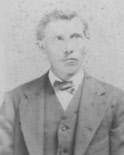
Emigrated in 1863 and settled near Brenham, Texas
Occupation: farmer
Married Charlotte Friederike Henriette Hüsemann of Oppenwehe in 1880
Children:
Louis Priesmeyer, born in 1882 near Brenham
Wilhelmina Priesmeyer, born in 1884 near Brenham
He then married Caroline Wilhelmine Henriette Kalkhake of Wehdem in 1887
Children:
Henry Priesmeyer, born in 1888 near Brenham
Wilhelm Priesmeyer, born in 1890 near Brenham
Lydia Priesmeyer, born in 1892 near Brenham
Elizabeth D. Priesmeyer, born in 1896 near Brenham
Walter Priesmeyer, born in 1899 near Brenham
Meta Hulda Priesmeyer, born in 1904 near Brenham
George Otto Priesmeyer, born in 1907 near Brenham
A daughter of the first marriage of Berend Heinrich Priesmeyer, with Marie Catharine
Hohlt, Sophie Henriette, born in 1791, was eventually chosen to inherit the farm,
which she did in 1815, when she married Wilhelm Heinrich Engelbrecht of Westrup.
Following the traditional custom in the area, Wilhelm Heinrich should then have adopted
the Priesmeyer surname, but evidently because he was a descendant of a distinguished
line of schoolmasters, he retained his own surname and thus passed it on to his descendants.
One of their sons, Carl Friedrich Wilhelm Engelbrecht,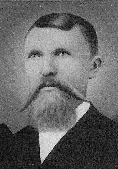 born in 1829, married Marie Charlotte
Menke of Oppenwehe; they emigrated with their children in 1869 and settled near Brenham,
Texas. One of their grandsons, Heinrich Wilhelm Engelbrecht, born in 1843, emigrated
to the Brenham area in 1860 and married Henriette Friederike Wilhelmine Winkelmann
of Oppendorf; they eventually settled in Crawford, Texas. Both of these immigrants
would have been surnamed Priesmeyer if the old naming customs had been applied in
1815 to the marriage of Sophie Henriette Priesmeyer and Wilhelm Heinrich Engelbrecht.
born in 1829, married Marie Charlotte
Menke of Oppenwehe; they emigrated with their children in 1869 and settled near Brenham,
Texas. One of their grandsons, Heinrich Wilhelm Engelbrecht, born in 1843, emigrated
to the Brenham area in 1860 and married Henriette Friederike Wilhelmine Winkelmann
of Oppendorf; they eventually settled in Crawford, Texas. Both of these immigrants
would have been surnamed Priesmeyer if the old naming customs had been applied in
1815 to the marriage of Sophie Henriette Priesmeyer and Wilhelm Heinrich Engelbrecht.
Today Oppenwehe 3, the original Priesmeyer farm, with the modern address of Oppenweher Strasse 9, is occupied by Herbert Engelbrecht, 9th great grandson of the earliest documented Priesmeyer on record, Heinrich, born in about 1570. The farm has thus been in continuous occupation by the Priesmeyer/Engelbrecht family for nearly 450 years, through twelve generations.
The Priesmeyers of Oppenwehe 50: Cincinnati and New York
We saw above that Gerd Heinrich Priesmeyer took over the new farm created for him
by his parents in 1670, at the time that he married Margarethe auf dem Holze of Oppenwehe
21. Thus began five long-
A child of the fifth generation, Johann Heinrich Priesmeyer, born in 1792, married Margarethe Charlotte Bosse, who was the widow of the heir to the Lammert farm at Oppenwehe 18. Johann Heinrich thus became holder of the Lammert farm, although he retained his own surname, since by that time the old naming custom had changed. Two of his sons emigrated to America:
Christian Friedrich Priesmeyer, born in 1828
Emigrated in 1853 and evidently died soon after arrival
Johann Heinrich Priesmeyer, born in 1830
Emigrated in 1850 and settled in Brooklyn, New York
Occupation: laborer, then grocer
Married Anne of Prussia in about 1851.
Children:
George H. Priesmeyer, born in about 1852 in New York
Emma Priesmeyer, born in about 1864 in New York
Dora Priesmeyer, born in about 1866 in New York
John L. Priesmeyer, born in 1868 in New York
Another of his sons, Christian Friedrich Wilhelm, born in 1832, was unable to find the heir to a farm to marry, so he married a laborer’s daughter and became a laborer himself. He had two sons before his untimely death at the age of 32; both of them ultimately emigrated:
Berend Friedrich Wilhelm Priesmeyer, born in 1861
Emigrated in 1903 to Cincinnati
Occupation: laborer
Married Henriette Charlotte Caroline Weggehöft of Oppenwehe 71 in 1889
Children:
Friedrich Wilhelm Priesmeyer, born in 1889 at Oppenwehe by 50
Wilhelm Friedrich Priesmeyer, born in 1891 at Oppenwehe by 50
Wilhelmine Henriette Priesmeyer, born in 1898 at Oppenwehe 66
Wilhelmine Henriette Caroline Priesmeyer, born in 1900 at Oppenwehe 66
Caroline Priesmeyer, born in 1903 at Oppenwehe 66
Harry Priesmeyer, born in 1905 in Ohio
Luella Priesmeyer, born in about 1908 in Ohio
Albert Priesmeyer, born in about 1912 in Ohio
Johann Friedrich Priesmeyer, born in 1864
Emigrated in 1880 to Cincinnati
Occupation: gardener
Married Elizabeth Schulte of Ohio in 1888
Children:
Frederick Henry Priesmeyer, born in 1889 in Ohio
Louis William Priesmeyer, born in 1892 in Ohio
Minnie Priesmeyer, born in 1897 in Ohio
One more immigrant came from the line of Oppenwehe 50, but she was not genealogically a Priesmeyer. She descended from Johann Friedrich Bockhorn, who took over the Priesmeyer farm and assumed the surname in 1799 at the death of the father of the above Johann Heinrich Priesmeyer, born in 1792. Since Johann Heinrich’s brother, the heir in that generation, was childless, the farm eventually passed to a grandson of Bockhorn, one of whose children emigrated:
Marie Charlotte Henriette Priesmeyer, born in 1865
Emigrated in 1883, arriving in Baltimore
Ultimate outcome unknown
The Priesmeyers of Oppenwehe 53: Taylor, Texas
We have already seen the expansion of the original Priesmeyer domains in 1662, when Heinrich Mundt and Catharine Priesmeyer divided the old Priesmeyer estate at Oppenwehe 3 into three farms, making provision for each of their sons, Thomas, Heinrich, and Gerd Heinrich. But there was still one more farm to come.
Thomas Priesmeyer’s oldest son, Martin, born in 1664, was not chosen as heir to his
father’s farm at Oppenwehe 3, so he followed an alternate and distinctive path to
prosperity. At the age of eighteen he married an elderly widow -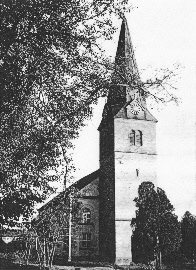 and it was not until 1710 that he was able to marry a younger
woman and have children of his own. In 1733 his first child, Gerd Heinrich, born
in 1711, inherited the family’s new farm in Oppenwehe, which had been given the number
53. For the next seven generations the family prospered there, although the number
of surviving children in each generation was small.
and it was not until 1710 that he was able to marry a younger
woman and have children of his own. In 1733 his first child, Gerd Heinrich, born
in 1711, inherited the family’s new farm in Oppenwehe, which had been given the number
53. For the next seven generations the family prospered there, although the number
of surviving children in each generation was small.
For American descendants of Oppenwehe 53, the most important event was the marriage
in 1852 of Heinrich Wilhelm Priesmeyer, a non-
Heinrich Wilhelm Priesmeyer, born in 1856
Emigrated in 1877 to Williamson County, Texas
Occupation: farmer
Married Caroline Charlotte Henriette Tiemann of Oppendorf in 1879
Children:
Henry Richard Priesmeyer, born in 1879 in Brenham, Texas
Fritz William Priesmeyer, born in 1881 in Williamson County, Texas
Emma Priesmeyer, born in 1883 in Austin County, Texas
Edward Henry Priesmeyer, born in 1885 in Williamson County, Texas
Wilhelmina Priesmeyer, born in 1888 in Williamson County, Texas
Ida Priesmeyer, born in 1892 in Williamson County, Texas
Lydia Priesmeyer, born in 1897 in Williamson County, Texas
Andrew Fred Priesmeyer, born in 1900 in Williamson County, Texas
Christian Friedrich Wilhelm Priesmeyer, born in 1859
Emigrated in 1880 to Williamson County, Texas
Occupation: farmer
Married Caroline Wilhelmine Henriette Henschen of Westrup in 1884
Children:
Adolph Carl Priesmeyer, born in 1888 in Austin County, Texas
Theodor H. Priesmeyer, born in 1893 in Austin County, Texas
Ida Priesmeyer, born in 1898 in Austin County, Texas
Caroline Henriette Engel Priesmeyer, born in 1863
Emigrated in about 1884 to Williamson County, Texas
Married Heinrich Friedrich Wilhelm Schwenker of Haldem in 1886
Carl Heinrich Priesmeyer, born in 1870, emigrated in 1888
Emigrated in 1888 to Williamson County, Texas
Occupation: farmer
Married Anna Louise Altus of Saxony in 1895
Children:
Helena Priesmeyer, born in 1896 in Williamson County, Texas
Frederick Priesmeyer, born in 1898 in Williamson County, Texas
Arthur John Priesmeyer, born in 1899 in Williamson County, Texas
As far as is known, they were the only offspring of Oppenwehe 53 to come to America. Their descendants now constitute a proud community based in Taylor, Texas, and they have published their own story on line.
Another child of this generation, Friedrich Heinrich Wilhelm, born in 1853, remained in Germany and settled in Brockum on farm number 18. Descendants of this line still live in the Brockum area and are actively involved in family history.
The Priesmeyers (Preasmeyer, Pruesmeyer) of Bonneberg:
Louisville, Kentucky
A branch unrelated to the Oppenwehe Priesmeyers is that of Louisville, Kentucky. This line originated in the village of Bonneberg, in Valdorf Parish, Westphalia. In the earliest records, the surname was actually Prüsner, but by about 1750 it had been altered to Prüssmeyer, evidently to distinguish the family from other Prüsner families in the parish.
In 1708, Johann Hermann Prüsner, heir to the family farm at Bonneberg 25, married Anne Hedwig Wittehus. Their great grandson, Johann Justus Friedrich Prüssmeyer, born in 1786, left Bonneberg and enlisted as a cannoneer in the Prussian Royal Artillery, stationed in the town of Minden. There he married Louise Margarethe Kohl of Petershagen, and they later settled in Petershagen. One of their sons, who wrote his surname as Priesmeyer or Preasmeyer, emigrated to America:
Carl August Priesmeyer, born in 1834 in Petershagen
Emigrated in 1860 to Louisville, Kentucky
Married Sophie Wilhelmine Caroline Marie Meyer of Petershagen in 1858
Children:
Charlotte Lina Sophie Priesmeyer, born in 1858 in Petershagen
Herman Albert Priesmeyer, born in 1861 in Louisville
Maria Lisette Friederike Auguste Priesmeyer, born in 1863 in Louisville
Heinrich Louis Priesmeyer, born in 1865 in Louisville
Wilhelmine Auguste Christine Priesmeyer, born in 1867 in Louisville
Louise Henriette Priesmeyer, born in 1869 in Louisville
Juliana Franziska Priesmeyer, born in 1871 in Louisville
Ella Priesmeyer, born in 1874 in Louisville
Alexander Priesmeyer, born in 1877 in Louisville
Anna Rebekka Priesmeyer, born in 1880 in Louisville
The Priesmeyers of Heddinghausen: Bond County, Illinois
Also not related to the Oppenwehe Priesmeyers is the lineage of Heddinghausen 9, in Holzhausen Parish, about twelve miles south of Oppenwehe. The antiquity of the farm suggests that it did not derive from Oppenwehe and that the similarity of the surnames is a coincidence. Even if there were a possibility of a connection before the beginning of written documents, the Heddinghausen line was itself cut off from its own Priesmeyer antecedents, so the descendants of the line are not genealogically Priesmeyers.
In 1730, the Priesmeyer heir of Heddinghausen 9 in that generation, Agnese Catharine, died young without producing a viable heir. Her widower, Jobst Hermann Klausing of Buer, Hannover, who had adopted the Priesmeyer surname at marriage, remarried and had a son, Caspar Heinrich, who eventually inherited the farm. A great grandson of Caspar Heinrich Priesmeyer came to America, evidently the only descendant of this line to emigrate:
Ernst Heinrich Priesmeyer, born in 1846 in Heddinghausen
Emigrated in 1882 and settled in Bond County, Illinois
Married Marie Louise Obermark of Buende in 1876
Children:
Louise Priesmeyer, born in 1877 in Heddinghausen
Johanne Friederike Elise Priesmeyer, born in 1879 in Heddinghausen
Henry Priesmeyer, born in 1882 in Illinois
Bernhard Priesmeyer, born in 1884 in Illinois
Emma Johanna Charlotta Priesmeyer, born in 1887 in Illinois
Wilhelmine Priesmeyer, born in 1889 in Illinois
Anna Priesmeyer, born in 1892 in Illinois
The Priesmeyers of Fischbeck: Morgan County, Missouri
A lineage that may have originated in Oppenwehe cannot now be connected, because it origins predated its first appearance in the written records, in Fischbeck, Hesse (in the modern state of Niedersachsen), about fifty miles southeast of Oppenwehe.
The earliest known ancestor of this line was Johann Cord Philip Priesmeyer, born in about 1707, who married Christine Sophie Peters in Fischbeck in about 1739. Their descendants lived for the following three generations in Fischbeck, and in about 1825 Heinrich Ernst Priesmeyer, born in 1803, left for Neersen, a village about fifteen miles to the south, near Bad Pyrmont in Niedersachsen. There he married Wilhelmine Dorothee Justine Jürgens in 1827, with whom he had eight children. After the death of his wife, in 1844, he married again, but in 1853, while still married, he had a son with unmarried Wilhelmine Caroline Catharine Wiedbrock.
In 1854, Heinrich and Wilhelmine, with their son, left Neersen for America and settled in Morgan County, Missouri. They evidently never married, probably because Heinrich could not conceal, upon investigation by their pastor, that he still had a wife in Germany:
Heinrich Ernst Priesmeyer, born in 1803 in Fischbeck
Emigrated in 1854 and settled in Morgan County, Missouri
Partner: Wilhelmine Caroline Catharine Wiedbrock (never married)
Children:
Heinrich Ernst Priesmeyer, born in 1853 in Neersen
Friedrich Priesmeyer, born in about 1856 in Morgan County, Missouri
Wilhelmine Caroline Margarethe Priesmeyer, born in about 1858 in Morgan County, Missouri
Ludwig Johann Priesmeyer, born in 1862 in Morgan County, Missouri
Gesche Margarethe Priesmeyer, born in 1864 in Morgan County, Missouri
Anna Catharina Priesmeyer, born in 1867 in Morgan County, Missouri
Louise Priesmeyer, born in 1870 in Morgan County, Missouri
The Priesmeyers of Hannover: Chicago and St. Louis
Three Priesmeyer immigrants came from the Kingdom of Hannover (the modern German state of Niedersachsen), according to U.S. census data. While they may have been connected in some way to the Oppenwehe Priesmeyers, further research is rendered difficult by the fact that the church authorities of Niedersachsen have not permitted the microfilming of their records, so they cannot be studied except in archives in Germany. However, future research may discover a connection:
E.F. Wilhelm Priesmeyer, born in 1845 in Hannover
Emigrated in 1867 to Chicago
Married Wilhelmine Baegner of Prussia in 1872
Children:
Wilhelmina Priesmeyer, born in 1873 in Chicago
Charles Priesmeyer, born in 1885 in Chicago
Edward Priesmeyer, born in 1887 in Chicago
Charles T.F. Priesmeyer, born in 1860 in Hannover
Emigrated in 1880 to St. Louis
Married Friederike Naber of Hannover in 1880
Children:
Clara Priesmeyer, born in 1880 in St. Louis
Hulda Priesmeyer, born in 1882 in St. Louis
Louise Priesmeyer, born in 1885 in St. Louis
Paulina Priesmeyer, born in 1888 in St. Louis
Henry H. Priesmeyer, born in 1864 in Hannover
Emigrated in 1881 to St. Louis
Married first in about 1887 and second in about 1894 in Missouri
Children:
Adelia Louise Priesmeyer, born in 1888 in Missouri
Walter L. C. Priesmeyer, born in 1890 in Missouri
Selma F. Priesmeyer, born in 1896 in St. Louis
Clara C. Priesmeyer, born in 1899 in St. Louis
NOTABLE PRIESMEYERS IN AMERICA
Many of our Priesmeyer cousins achieved success pursuing the opportunities available to them in America, but several were especially noteworthy. The following sketches highlight those who were particularly prominent during their lives.
August Priesmeyer and the A. Priesmeyer Shoe Company
The most successful member of the first Priesmeyer generation in America was Heinrich
Wilhelm August Priesmeyer, born in 1832 at Oppenwehe 47. He was among the earliest
of the immigrants, depa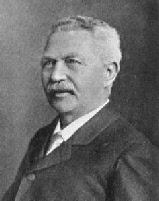 rting in 1849, one year after his older brothers Heinrich
and Gottlieb. Like them, he settled initially in Cincinnati, where he first worked
as a farmhand and then served a two-
rting in 1849, one year after his older brothers Heinrich
and Gottlieb. Like them, he settled initially in Cincinnati, where he first worked
as a farmhand and then served a two-
In 1859 August opened a shoe store at Washington Avenue and Sixth Street in St. Louis.
The following year he was recorded in the census as a shoemaker residing in the ninth
ward of St Louis; living with him were his brothers Gottlieb and Carl as well as
his cousin Gottlieb (born in 1834), who had immigrated in 1852. In 1860 he married
Caroline Steinbrügge, a 21-
Like many industrious Germans in St. Louis in the 1860s, August evidently benefited
substantially from opportunities provided by the economic expansion during the U.S.
Civil War. Following brief service with the Union army, he returned to shoemaking,
and in 1869 he opened another shoe store, at Washington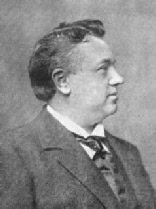 Avenue and Fourth Street,
after an unsuccessful attempt at diversification into the hide and tobacco business.
The following year, he was recorded as living in the eleventh ward of St. Louis and
possessing real estate worth $10,000 and personal property worth $48,000 -
Avenue and Fourth Street,
after an unsuccessful attempt at diversification into the hide and tobacco business.
The following year, he was recorded as living in the eleventh ward of St. Louis and
possessing real estate worth $10,000 and personal property worth $48,000 -
 In 1874 August moved to Jefferson City, where he opened a shoe factory, employing
35 workers, in partnership with F. Woesten, whom he bought out two years later. His
motivation for the move is described in a recent history of Jefferson City:
In 1874 August moved to Jefferson City, where he opened a shoe factory, employing
35 workers, in partnership with F. Woesten, whom he bought out two years later. His
motivation for the move is described in a recent history of Jefferson City:
Fiscal conservatism and local rule were key concepts enshrined in a new constitution adopted by Missouri citizens in 1875. One consequence of the effort to cut down on the amount of money needed to run state government was a renewed effort to force convicts to finance their own incarceration. Prison and governmental officials decided to have the state construct factories inside the prison walls and then negotiate multiyear contracts with private entrepreneurs for the use of convict labor. Governor John S. Phelps summarized the plan in his 1879 message to the General Assembly: “[I]t would seem reasonable to expect that the prisoners would not only be able, by their labor, to earn an amount sufficient to support themselves but also to pay the salaries and wages of the officers and guards.” This new prison factory system brought to Jefferson City a number of entrepreneurs who would not, under other circumstances, have chosen the city as a place to set up business. One of the first of these was August Priesmeyer, president and founder of the A. Priesmeyer Shoe Company, who moved to Jefferson City in 1874 to open a factory inside the prison walls. Priesmeyer managed the business largely with the help of his nephew, Henry F. Priesmeyer, and a Scottish immigrant named John Tweedie.
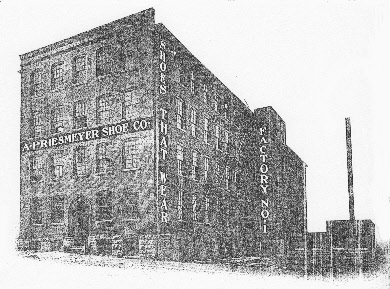 In 1891 August retired from active management and moved to 1537 South Grand Avenue
in St. Louis. In 1899 he incorporated his shoe business, with himself as president,
John Tweedie as vice president and factory superintendent, and his nephew Henry F.
as secretary/treasurer. By that year, the factory employed 250 workmen as well as
18 salesmen, covering nearly all of the United States with the exception of the northeast.
In 1891 August retired from active management and moved to 1537 South Grand Avenue
in St. Louis. In 1899 he incorporated his shoe business, with himself as president,
John Tweedie as vice president and factory superintendent, and his nephew Henry F.
as secretary/treasurer. By that year, the factory employed 250 workmen as well as
18 salesmen, covering nearly all of the United States with the exception of the northeast.
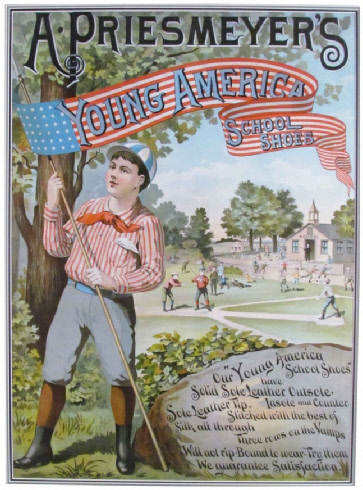 In later life, August enjoyed his accumulated wealth, traveling twice to Europe in
1897 and also making a 14-
In later life, August enjoyed his accumulated wealth, traveling twice to Europe in
1897 and also making a 14-
William H. Priesmeyer, Chemical Merchant
Another significant success story of the first generation of immigrants began with the 1851 arrival in St. Louis of Heinrich Friedrich (Henry F.) Priesmeyer, born in 1831 at Oppenwehe 70. In 1860 in married Anne Marie Gaus, a widow from Prussia, and in that year they were listed in the census, with Henry working as a grocer and Anne managing the boarding house in which they were living, with 26 other residents.
Like his prominent cousin August, whom we met above, Henry evidently benefited from opportunities offered by the U.S. Civil War. In 1864 he started a business packing and wholesaling chemicals and especially saltpeter, a constituent of gunpowder. To help him with the enterprise, in 1866 he brought to America his 1st cousin Heinrich Wilhelm (William H.) Priesmeyer, born in 1847 at Oppendorf 99. When Henry died, in 1870, leaving an estate of $20,000 in real property and $5,000 in personal property, William evidently took over the business. Two years later he married Henry’s widow Anne.
By 1880 William and Anne had successfully maintained the business and were living
at 1001 Carr Street in St. Louis with their son Frederick and with Henry’s two children,
Johann Heinrich Wilhelm (Henry John) and Matilda Anna. Within a few years they moved
to 1541 South Grand Avenue, next door to August Priesmeyer (discussed above); it
should be noted that August named William as co-
In addition to the chemical wholesaling business that he had inherited from his cousin,
William established and operated the Priesmeyer-
William died in 1927, and his step-
Henry F. Priesmeyer and the Priesmeyer Stores of Texas
A particularly engaging chapter in the saga of the first immigrant generation is
the life of Heinrich Friedrich (Henry F.) Priesmeyer, born in 1885 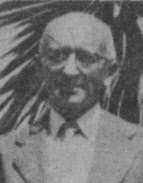 at Oppendorf 21.
In 1901 he arrived in St. Louis, where he lived for nine years. He had expected to
apprentice himself to a baker, but his first job was as an elevator operator, after
which he found employment as a traveling salesman with the Wertheimer-
at Oppendorf 21.
In 1901 he arrived in St. Louis, where he lived for nine years. He had expected to
apprentice himself to a baker, but his first job was as an elevator operator, after
which he found employment as a traveling salesman with the Wertheimer-
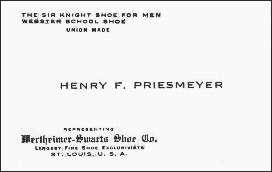 From the beginning, Henry was notable for his energy and ambition. Starting in 1910
he joined with his older brother Christian Friedrich Wilhelm (William) in a series
of investments in oil development rights in rural Texas and was still active as a
“wildcatter” in the 1960s. He fancied himself an amateur geologist and over the years
brought in several producing wells. In his 80s he wrote wistfully of his early days
in the oil patch and reminisced over missed opportunities. But this was just an exciting
sideline. To support his family, in 1917 he opened a general store in Garwood, Texas,
which he named, appropriately, Priesmeyer’s Store. He eventually added three more
stores in nearby communities, reinvesting all of his profits, and the business was
successful. The store in Sweeny was his “newest and last,” he wrote, with $148,000
invested and a monthly payroll of over $1 million. A feature article in the Houston
Post in 1983 reported from Garwood that,
From the beginning, Henry was notable for his energy and ambition. Starting in 1910
he joined with his older brother Christian Friedrich Wilhelm (William) in a series
of investments in oil development rights in rural Texas and was still active as a
“wildcatter” in the 1960s. He fancied himself an amateur geologist and over the years
brought in several producing wells. In his 80s he wrote wistfully of his early days
in the oil patch and reminisced over missed opportunities. But this was just an exciting
sideline. To support his family, in 1917 he opened a general store in Garwood, Texas,
which he named, appropriately, Priesmeyer’s Store. He eventually added three more
stores in nearby communities, reinvesting all of his profits, and the business was
successful. The store in Sweeny was his “newest and last,” he wrote, with $148,000
invested and a monthly payroll of over $1 million. A feature article in the Houston
Post in 1983 reported from Garwood that,
Priesmeyer’s is mainly a western store now -
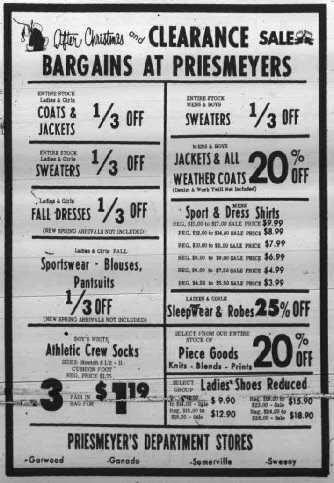 Within just a few years, however, the chain of Priesmeyer stores was overwhelmed
by the arrival of Walmart in rural Texas. Henry’s grandsons, who were then managing
the stores, simply could not compete with the giant chain’s massive selection and
low prices. They recall that, as the end neared, life-
Within just a few years, however, the chain of Priesmeyer stores was overwhelmed
by the arrival of Walmart in rural Texas. Henry’s grandsons, who were then managing
the stores, simply could not compete with the giant chain’s massive selection and
low prices. They recall that, as the end neared, life-
Henry retained an abiding devotion to family and to family history. He traveled many times to his birthplace in Oppendorf and insisted that his children and grandchildren meet and communicate with their German cousins. He also formed a strong friendship with Paul Theodore Priesmeyer, forty years his junior, who had early become obsessed with the history of the entire Priesmeyer clan. Paul was from nearby El Campo, and both he and Henry were convinced that they must be cousins. They set out to discover the exact relationship and worked together on the project, interviewing Priesmeyers wherever they found them, both in America and in Germany. They were not deterred by obstacles, even when an old woman in the village of Quernheim (origin of the El Campo branch) insisted that their two lines were unrelated to each other. Unfortunately, they were unable to solve the mystery in their lifetimes. One can only wish that they had learned the answer, as a reward for all their devotion: we now know that Henry and Paul were 7th cousins, once removed.
Henry died in 1975, at the age of 90. His grandchildren remember him fondly and reverently as the strong, industrious, ingenious, thrifty, devoted, and loving head of their family.
The database developed for this family history project currently contains nearly
one thousand Priesmeyer-
If you would like to see your ancestor’s family tree, it can be accessed on Ancestry.com. Use Ancestry’s search engine, entering your ancestor’s name and birthdate. Since German immigrants typically chose to use a single anglicized given name in America, it is important that you first identify your ancestor using the summary list, which shows both their German and American given names as well as their birthdates. Once you’ve reached your immigrant ancestor’s profile page on Ancestry.com, click on “Tools/View in Tree” to see the family tree. If you need help, please contact the author.
You’ll observe that farm numbers are indicated throughout the family trees, which is helpful if you visit the area and wish to see the locations of your ancestors’ homes. It should be acknowledged, however, that these numbers are an anachronism before about 1680, when they were established officially in the community. Before that time, farms were referred to, for example, as simply “Priesmeyer’s place.” If the farm number is preceded by the word "by," it means that the family was not the farm holder but rather were landless laborers (Heuerlinge) who were living in a cottage located on the farm.
All records in the database are documented with source notes. The parish churchbooks
are by far the most important source -
Conzen, Kathleen Neils, “Germans,” in the Harvard Encyclopedia of American Ethnic
Groups, ed. Stephan Thernstrom (Cambridge, 1980), pages 405-
Das Dorf Dielingen im Wandel der Zeiten, published by the St. Matthias Bruderschaft of Dielingen (Rahden, 2003).
Hillebrand, Stefanie, Jüdische Geschichte in Levern und Umgebung, 1800-
Kammeier, Heinz-
Kamphoefner, Walter D., The Westfalians, from Germany to Missouri (Princeton, 1987).
Kamphoefner, Walter D., and Wolfgang Helbich (eds.), Germans in the Civil War: the Letters They Wrote Home (Chapel Hill, 2006).
Kamphoefner, Walter D., Wolfgang Helbich, and Ulrike Sommer (eds.), News from the Land of Freedom: German Immigrants Write Home (Ithaca, 1991). The best available introduction in English to the experiences of German immigrants in America. Excellent summary essays and notes by Professor Kamphoefner.
Koop, Kai Ole, Das Dorf Drohne: Aspekte der siedlungsgeographischen und genealogischen Entwicklung einer westfälischen Bauerschaft seit dem frühen Mittelalter (Rahden, 2013).
Nordsiek, Hans; Heinz Redecker; et al, Tausend Jahre Levern: Beiträge zu seiner Geschichte (Minden, 1969). Among the best of the available local histories.
Oppenwehe: Festschrift zur 775-
Redecker, Heinz, Ein Dorf blickt zurück: 750 Jahre Niedermehnen (Lübbecke, 1992).
Redecker, Heinz, Stemwede: junge Gemeinde, alte Dörfer (Lübbecke, 1994). Excellent collection of photographs, with informative summary essays.
Redecker, Heinz (ed.), Chronik von dem Kirchspiel Levern, 1800-
Redecker, Heinz, et al, Haldem: die Geschichte eines westfälischen Dorfes (Espelkamp, 1986). Among the best of the available local histories.
Rippley, La Vern J., The German-
Schumacher, Erich, Oppendorf -
So war es in Arrenkamp -
von Husen, Ludger (ed.), Geschichte der Gemeinde Marl, 1140-
von Husen, Ludger, and Horst Meyer, Flecken Lemförde: eine 750-
von Husen, Ludger, and Horst Meyer, Stemshorn: eine 750-
Wiegel, Bert (ed.), Chronik von dem Kirchspiel Wehdem, 1819-
Wittich, Werner, Die Grundherrschaft in Nordwestdeutschland (Leipzig, 1896). The classic study.
Wollgramm, Heinz, et al, 1000 Jahre Wehdem, 969-

This site was written and designed by Robert Jackson, great-
Please feel free to make suggestions for improving this site!